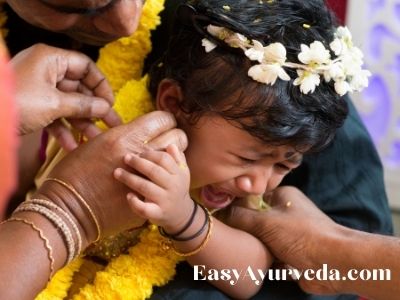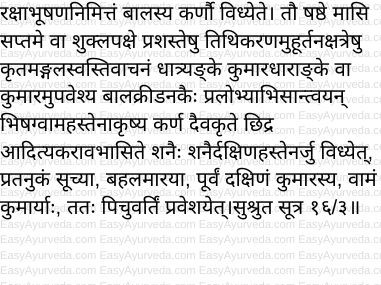Ear Piercing Ceremony Karnavedhana Samskara
By Dr Raghuram Y.S. MD (Ay) & Dr Manasa, B.A.M.S
Karna Vedhana Samskara is a ceremony in which the earlobe of the child is pierced. Like the other ceremonies, this one too is celebrated amidst family, friends and well wishers in a ritualistic way.
Karna = ear / earlobe
Vedha / Vedhana = piercing
Samskara = ceremony / ritual
It is also called Karn Vedhan Sanskar
Read – Infant Care As Per Ayurveda: Initial 6 Months

Table of Contents
When is this ceremony conducted?
Earlobe piercing ceremony is celebrated in the 6th or 7th month of the child’s life.
There is difference of opinion regarding the time period in which this ceremony is conducted.
According to Master Sushruta – it is conducted in the 6th or 7th month.
According to Master Vagbhata, it shall be conducted in the 6th, 7th or 8th month.
According to Master Dalhana, commentator of Sushruta Samhita, 6th or 7th month is not to be counted from birth of the child but shall be counted from the ‘Bhadrapada month’ of the Hindu calendar. Thus, 6th or 7th month in which earlobe piercing ceremony needs to be done falls in the Magha or Phalguna months of the Hindu calendar.
What is the logic of conducting the earlobe piercing ceremony during this time period?
These two months i.e. Magha and Phalguna fall in the Shishira season of the Hindu calendar i.e. late winter season. Earlobe piercing is done in this season because the child will have optimum strength in this season. There will also be less possibility of the wound (if any caused due to piercing) getting suppurated during this season. Even if the wound gets suppurated, it gets healed in quick time.
Read – Symptoms That Hint Towards Different Diseases In Babies
Procedure of conducting earlobe piercing
Master Sushruta has given a detailed account of ear piercing ceremony and the complications encountered during the procedure.

The twofold purpose of conducting earlobe piercing ceremony is –
- Raksha karma – as a protective measure for the child
- Abhushana nimitta – for planting ear ornaments (ear ring etc)
How to perform the ceremony?
An auspicious day, star constellation and moment is selected during the brighter half of the lunar cycle, in the 6th or 7th month as already mentioned.
Auspicious rituals and holy recitations should be conducted. Following this, the child should be placed in the lap of wet-nurse or male child attendant.
The child should be given with toys to play to divert the attention of the child from the ceremonious procedures.
Now the physician should gently pull the ear of the child with his left hand while holding a sterile needle in his right hand. With the help of the needle the physician should cautiously pierce the earlobe of the child exactly at the natural orifice at the center of the lobe through which the sunlight passes. This orifice is called as Daivakrita Chidra i.e. ‘God made natural orifice’. The needle should be pierced straight without causing discomfort to the child. The needle used should be thin. In case of male child, the right earlobe should be pierced first. On the other hand, the left earlobe shall be pierced in case of female child. After piercing the earlobe, the physician should gradually insert a medicated / lubricated wick into the orifice.
Master Vagbhata emphasizes that a mark should be done on the earlobe wherein it needs to be punctured. Later the physician should pierce that mark straight and quick with a needle without causing discomfort. The piercing should neither be done too above or too below or too much to the side of the mark. It should be done straight on to the mark made on the earlobe.
Read – Jewellery Allergy: Causes, Home Remedy, Ayurveda Treatment
Signs of proper earlobe piercing
When the piercing is done at the right spot of the earlobe as mentioned above it doesn’t cause bleeding or pain. On the contrary if it is done at wrong place other than the mentioned point of the earlobe, it will surely cause pain and bleeding. In the ‘naturally formed divine orifice of earlobe’ mentioned in Ayurveda texts, there will be absence of veins, arteries and nerves. Therefore when pierced in that spot there arises no question of bleeding or pain. In places other than this spot since there will be presence of plenty of blood vessels, bleeding will obviously occur. The presence of nerves in these places will cause pain when pierced in these places.
Effect of piercing and damaging the blood vessels and nerves in the ear
According to Ayurveda, there are three kinds of siras i.e. blood vessels and nerves in the external ear. They are –
- Kalika – piercing or injuring these structures causes fever, swelling, pain and burning sensation.
- Marmarika – piercing or injuring these structures causes fever, pain and knots.
- Lohitika – piercing or injuring these structures causes stiffness of the nape of the neck, tetanus, stiffness in the head, earache and other symptoms.
In these conditions symptomatic treatment shall be done.
Other reasons of symptoms caused due to wrong piercing of earlobe
- Needles which are rough, oblique, crooked, stout and unclean
- Use of thick wicks / thread
- Hyperactive and unsettled child
- Inefficiency of the physician (wrong conduct of procedure of piercing)
Read – Ayurvedic Treatment For ADHD – Herbs, Therapies, Medicines, Remedies
Treatment for complications caused due to earlobe piercing
If there is swelling or pain in the ear, the cotton wick introduced inside the orifice should be immediately removed.
The paste of the below mentioned herbs should be continuously applied mixed with ghee and honey on the wound until it gets completely healed –
- Licorice – Glycyrrhiza glabra
- Roots of Ricinus communis
- Manjishta – Rubia cordifolia
- Barley – Hordeum vulgare
- Sesame
Once the wound gets healed, earlobe should be once again pierced properly as explained above.
If the piercing has been done properly, the orifice should be constantly showered / sprinkled with unripe oil of sesame. Every alternative day thicker unctuous wicks should be introduced into the pierced orifice and the orifice showered with unripe oil of sesame.
When all the contaminants and complications settle down, the orifice shall be expanded to any desired size by using small sized dilators.
Click to Consult Dr Raghuram Y.S. MD (Ayu)









